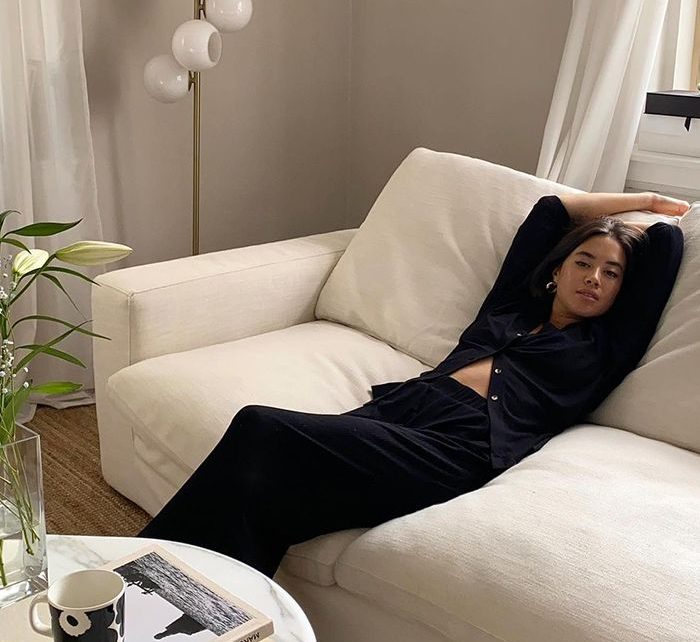If you started the New Year wanting to be more regimented with your skincare routine, just know that you’re not alone. A new year, after all, marks a time for change and resolution. For many, an effective and considered skincare routine acts as the perfect way to feel pulled-together and in control.
The downside to skincare-related New Year’s resolutions, however, is that it is very easy to fall at the first hurdle. A seemingly quick and innocent search for skincare advice will only leave you bombarded with an abundance of oftentimes conflicting information on all things cleansing, serums, retinol, hyaluronic acid, vitamin C, moisturiser, SPF and so on.
With so much information out there, we don’t blame you if you’re feeling a little bamboozled. You see, we beauty insiders can all too often get caught up in the nuances and forget to address the real basics. As a result, insight into what a basic skincare routine should look like is hard to come by.
But fear not, because we have you covered. If you’ve marked 2022 as the year you start your skincare journey, consider this your starting point. Yes, there are complexities to every point (no two faces are the same, after all), but intricacies can come later. We reached out to two leading dermatologists on what makes the ultimate basic skincare routine. Keep scrolling to start your skincare journey. It’s wonderful to have you onboard.
Ask any skincare expert out there, and they will agree that cleansing is the single most important part of any skincare routine. Even if you don’t find the time to do anything else, washing your skin should never be skipped. “Cleansing should be a part of both your morning and evening skincare routine,” says Rayhaneh Zahedi, a dermatology specialty doctor at Quality Health Care Ltd. “It removes impurities, pollution and sebum, creating the perfect canvas for serum application and absorption,” she adds.
The good news is your cleansing routine doesn’t have to be complicated. “I have always been an advocate of the less-is-more approach. You just need to find the products which work for you,” says Alexis Granite, CeraVe consultant dermatologist.
To create a blank canvas, keep skin irritation to a minimum and help work out what products you might need next, start with a cream or creamy-gel cleanser. This will provide the necessary means to effectively cleanse your face without causing upset.
Glossier’s Milky Jelly Cleanser is a cult product for a reason. The gel-like formula effectively cleanses skin without stripping it of essential moisture. Plus, it looks really great on the shelf.
Another aesthetically pleasing product, this creamy cleanser doesn’t contain any overbearing fragrance and just leaves skin looking its healthiest.
Many experts will argue that you don’t need an eye cream, and they’re not wrong. However, when you start a basic skincare routine, it’s good to get into the habit of applying one so that you can work out whether or not you feel the need in the future. For the morning, look for brightening and refreshing creams and gels that will help revive tired eyes.
With a metal-tip applicator and brightening ingredients, this affordable eye cream is the perfect way to inject some life into morning eyes.
Packed with vitamin C and a special peptide blend, this eye cream de-puffs, illuminates and nourishes in a matter of seconds.
This is where things risk getting a little confusing and tricky, but we assure you it’s simple once you know the basics. Serum is the hardest-working beauty product out there. It’s lighter than a moisturiser and contains really efficacious ingredients. What serum you choose depends on your skin type. “Serums are light in texture and are packed with active ingredients. They’re best used after cleansing, allowing them to absorb more effectively and do their best work,” says Granite.
As a rule, a good place to start is either with a hydrating serum (one that contains hyaluronic acid or ceramides) or a vitamin C, which helps boost luminosity and protect the skin from ageing aggressors such as pollution. “The morning is all about defence,” says Zahedi. “A protective vitamin C serum is every dermatologist’s go-to a.m. superhero.”
Containing both hyaluronic acid and vitamin C, this glow-boosting serum proved a favourite for Who What Wear shopping editor Joy Montgomery when she really started getting to grips with her skincare routine.
The price tag of this might make you weep, but we assure you there is no vitamin C serum out there as efficacious as this one. It really does deliver all of the antioxidant protection (that’s the defence we talked about earlier) it promises and delivers a healthy glow boost while it’s at it.
The truth is, unless your skin is particularly dry, you don’t always need to apply a moisturising cream in the morning. It’s actually best to start with an SPF cream and suss it out from there. “SPF should be the final step in your morning skincare routine. It’s vital in protecting skin against harmful UVA and UVB rays and should be worn daily over the top of your other skincare. I’m currently using Ultra Violette Queen Screen SPF50,” says Granite.
This lightweight SPF is regarded as one of the best in the biz amongst dermatologists and beauty editors. It has a semi-matte finish that leaves skin looking like skin.
A new SPF on the block, this stuff is quickly becoming one of the most recommended sunscreens around. It’s lightweight, has a silky texture and is generally wonderful to use.
The truth is you don’t really have to use a different cleanser in the evening to the one you used in the morning. However, it is important to note that you have more dirt, makeup and sebum to wash off your face in the evening, so it’s important to pay close attention to this step. “Without using a dedicated facial cleanser, you’ll leave behind grime and oil, which may lead to clogged pores, breakouts and irritation from residual product on the skin,” says Granite.
If you want something a little harder-working for the evening, try a gel cleanser. “If you have makeup residue left over, I recommend removing with a micellar water like CeraVe’s Hydrating Micellar Water,” Granite adds.
This clever micellar water won’t dry out the skin, as it contains hydrating ceramides and niacinamide. It’s ideal for removing residual makeup either pre- or post-cleanse.
Another beauty-buff favourite, this gel cleanser leaves skin feeling suitably refreshed and isn’t overly drying.
Again, eye cream application in the evening isn’t essential, but if you enjoy the process of applying it, you absolutely should. If you’re looking to include retinol in your evening skincare routine (we’ll get there in a minute), apply a hydrating cream around the eye area to buffer penetration. Or if you’re up for it, look for specialised retinol eye creams to deliver the right amount of active ingredient and avoid irritation.
This eye cream showcases basic skincare at its finest. With hydrating ceramides and hyaluronic acid, it gives your eye area everything it needs to keep moisturised.
This stuff contains retinol to help target dark circles and fine lines along with a plethora of hydrating ingredients to mitigate potential irritation.
This is the step you have likely been waiting for. Your night-time serum should, ideally, be tailored to your skin’s wants and needs. Assuming you’re not entirely sure what they are yet, it is probably best to opt for a basic hydrating serum that contains ceramides or hyaluronic acid.
However, your skin might also benefit from a retinol serum if you are over 30. “Vitamin A serum (retinol) is the gold standard. It supports the skin in almost every way, targeting discolouration, breakouts and ageing. For skincare newbies, I would always recommend having a skincare consultation with an expert to get to know your skin first,” advises Zahedi.
If you feel as though you’re ready to try a retinol serum (it can come with drying and irritating side effects), now is the point in your routine to do so. Look for low-strength serums first and apply once a week. As your skin gets used to the serum, slowly up your application to twice a week and then every other night.
Using encapsulated retinol, this serum is ideal for those embarking on their retinol journey. Expect glowing, smoother skin come morning.
This stuff is regarded as one of the best retinol products around. It comes in different strengths so that you can gradually work your way up the retinol ranks.
“A lot of patients ask me if they need to use a specific evening moisturiser, and the answer is not necessarily. If you use a moisturiser in the morning (besides your SPF), you might want to use a richer one at night, but if you find a lighter or richer one that works twice a day, that’s absolutely fine too,” says Granite.
As a rule, it’s best to keep your moisturiser simple and get your active ingredients via your serum instead. Look for creams or lotions that contain hydrating and moisturising ingredients, such a hyaluronic acid, niacinamide and ceramides. If you find your moisturiser to be too rich or not rich enough, look for thicker or thinner textures.
This stuff is perfect for everyday hydrating. It helps to soothe dryness, tightness and itchiness by giving your skin the essentials.
Jam-packed with hyaluronic acid, collagen and ceramides, this cream is one of the best around for plumping, skin-repairing goodness. Next up, I’m a beauty editor—these are the seven things I’m spending my money on this year.





